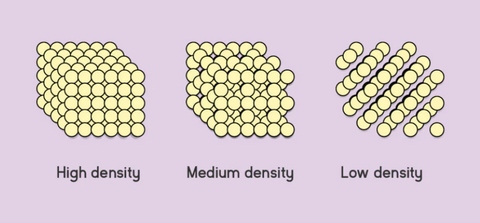
Memory Foam Density- How It Matters Sleeping Quality
When we consider purchasing memory foam products, we often experience seemingly identical items with vastly different price ranges. As consumers, this can be perplexing, leaving us unsure about the significant price variations. What factors influence the price of these products? Is it the brand or the quality itself?
As a brand and manufacturer with years of experience in producing and selling memory foam products, QUTOOL would like to share more knowledge about memory foam, hope it could help you in finding high-value memory foam products. The primary factor influencing the price of memory foam products is weight. For instance, memory foam pillows of the same volume are priced higher when they are heavier. In other words, memory foam with greater density also commands a higher price.
- How is Foam Density Measured?
The density of memory foam is typically represented by the symbol D, where D=kg/m³. For example, 25D would indicate that the foam weighs 25kg per cubic meter.

- Does the density of the product affect the firmness?
In general, Density and mattress firmness are not necessarily related. Firmness depends more on the firmness of the foam itself, depth of memory foam, and the formulation of the sponge. This means that memory foam products with same density can be made in different levels of firmness. You can also find both low-density and high-density memory foam products that range from soft to firm.
- How does the density of the sponge affect the product?
1) Durability
Denser memory foam products are known for their durability due to a higher concentration of foam material. Their firmness allows them to withstand repetitive nightly wear and tear. With proper care and maintenance, a high density memory foam pillow can last for years, making it a long-term investment compared to low density one.
2) Foam Response Time
The density of memory foam can have a significant impact on its response time. Generally, memory foam with higher densities takes longer to respond to pressure changes than lower density foams. This is because the higher density foam has more material and a tighter cell structure, which makes it more difficult for air to flow through. As a result, it takes longer for the foam to adjust to changes in pressure. It's important to consider the desired response time when selecting a memory foam product, as well as the desired level of support and comfort.
For example, QUTOOL cervical pillow with high density memory foam and the response time is 3-5 seconds, this is the most comfortable using experience
3) Sleep Quality-Different Support
If you often wake up with discomfort, for example the stiff neck, sore neck muscles. It’s the time for you to change a new pillow with comfortable curve and enough support. Higher density memory foam pillows provide better support and contour to your head and neck, reducing pressure points and promoting proper spinal alignment. This can result in a more restful and comfortable sleep, as well as alleviate any discomfort or pain. If you have to constantly adjust the pillow in the middle night, it means that your pillow support it not enough, maybe caused by the lower density. Lower density memory foam pillows may not hold their shape as well over time, potentially leading to a less comfortable sleeping experience. Therefore, when considering a memory foam pillow, it is important to take into account the density of the foam to ensure it meets your specific sleep needs.





